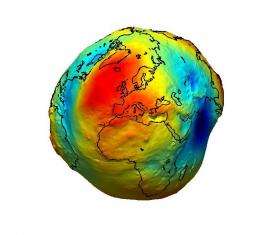October 1, 2012 report
Researchers say atomic clocks now good enough to measure Earth's geoid

(Phys.org)—Researchers from the University of Zurich say that atomic clock technology has sufficiently progressed to the point that it should now be feasible to use them to measure the Earth's geoid, thereby producing more accurate geophysical estimates of oil and mineral deposits, as well as water reservoirs. The team, led by Ruxandra Bondarescu write in their paper published in Geophysical Journal International, that atomic clock accuracy now approaches a frequency ratio inaccuracy of 10-18 which they say should provide an accuracy in measuring a equipotential surface area equivalent to just one centimeter.
The teams' ideas are based on the part of general relativity that says that the mass of an object can cause a curve in space time resulting in a slowdown of time itself. For an object as massive as the earth, differences in time relative to sea level can be observed and measured. Those differences create what is known as the geoid or the equipotential of our planet. Because of this, it should be possible to use clocks to measure how fast time is progressing at different points on the planet. Those running below sea level should run slower than those at or above the surface, and now, the team says, because of advances in the accuracy of atomic clocks, it should be possible to use them to measure the differences in time at different points on the surface of the earth to create maps of what lies below due to the different densities of materials; the more dense the material the slower the clock will read.
The team suggests that two clocks could be connected together via fiber cable to allow for comparing the differences in the passage of time, allowing for calculations of the density of whatever lies below the surface resulting in accurate predictions of its type, e.g. water, rock, oil, etc. They say such calculations should be much more accurate than other methods currently in use, i.e. satellites. They add that using atomic clocks to measure the geoid could also be used to measure how the mass of the earth changes over time, such as what happens as ice melts at the poles.
One stumbling block to using atomic clocks in this manner, they say, is that they are still too large. More portable clocks would make measuring any spot on Earth conceivable, and would also make it possible to place them aboard spacecraft, which would allow researchers to study such things as the dark matter halo of the Earth.
More information: ruxandrab.blogspot.com/2012/09 … e-of-earth-with.html
Article citation: Geophysical applicability of atomic clocks: direct continental geoid mapping, DOI: 10.1111/j.1365-246X.2012.05636.x . arXiv:1209.2889 [physics.geo-ph] arxiv.org/abs/1209.2889
Abstract
The geoid is the true physical figure of the Earth, a particular equipotential surface of the gravity field of the Earth that accounts for the effect of all subsurface density variations. Its shape approximates best (in the sense of least squares) the mean level of oceans, but the geoid is more difficult to determine over continents. Satellite missions carry out distance measurements and derive the gravity field to provide geoid maps over the entire globe. However, they require calibration and extensive computations including integration, which is a non-unique operation. Here we propose a direct method and a new tool that directly measures geopotential differences on continents using atomic clocks. General Relativity Theory predicts constant clock rate at sea level, and faster (resp. slower) clock rate above (resp. below) sea level. The technology of atomic clocks is on the doorstep of reaching an accuracy level in clock rate that is equivalent to 1 cm in determining equipotential surface (including geoid) height. We discuss the value and future applicability of such measurements including direct geoid mapping on continents, and joint gravity and geopotential surveying to invert for subsurface density anomalies. Our synthetic calculations show that the geoid perturbation caused by a 1.5 km radius sphere with 20% density anomaly buried at 2 km depth in the crust of the Earth is already detectable by atomic clocks of achievable accuracy. Therefore atomic clock geopotential surveys, used together with relative gravity data to benefit from their different depth sensitivities, can become a useful tool in mapping density anomalies within the Earth.
Journal information: Geophysical Journal International
© 2012 Phys.org


















